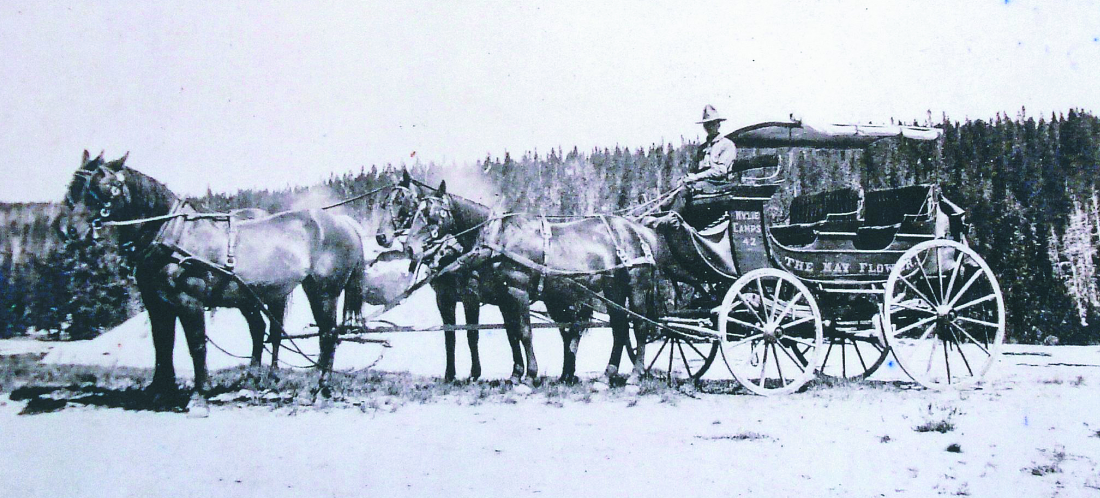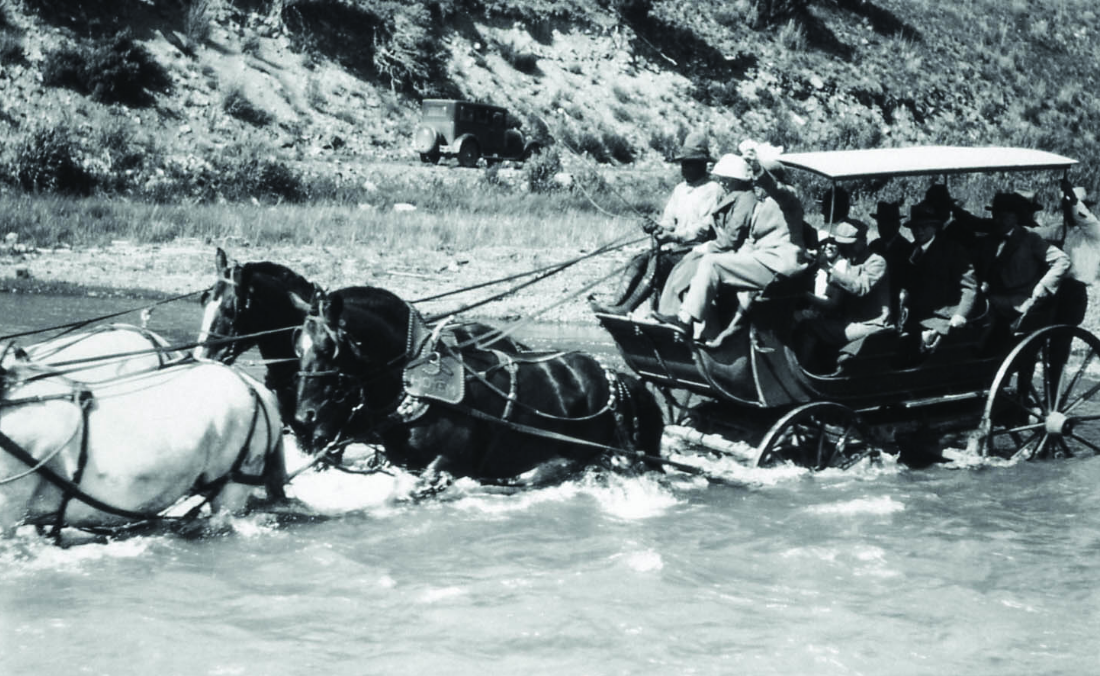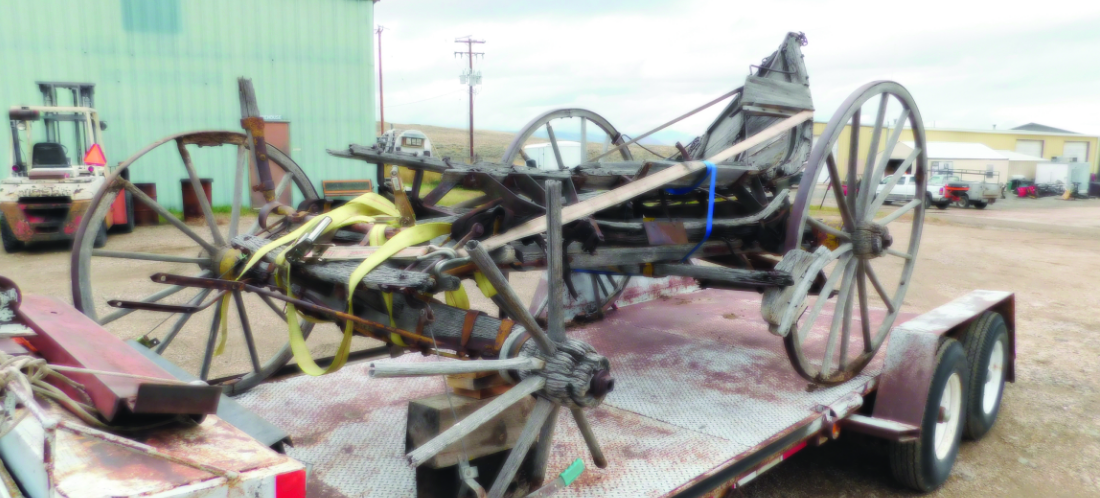Rawhide Johnson is a stagecoach historian and conservator, a title that only begins to hint at the decades of work he’s put into preserving some of the rarest pieces of Western history. I met Johnson for lunch, but our conversation quickly drifted to the place he calls home: his workshop. He described his workshop just outside of Cody, Wyoming, filled with stagecoaches, artifacts, photos, and research. “If you came to my shop to look at the archives, you could spend a couple of days,” he said with a laugh.
For Johnson, stagecoaches aren’t relics. They’re living connections to the stories, people, and landscapes of the American West. His work with stagecoaches began in high school with the restoration of a mud wagon from the Big Hole Stage Company. The May Flower, his 23rd stagecoach restoration, may be the most important of them all.
Johnson grew up in the Centennial Valley in Montana on what he called a “starvation ranch.” In 1931, his father purchased the Big Hole Stage Company and acquired the entirety of the operation. “Horses were going for $3 a head during the Depression,” he said. “Along with them came harnesses—some of which I still have. One harness turned out to be from J.R. Hill of Concord, New Hampshire. Ken Wheeling, a famous stagecoach expert, told me it was worth more than most entire coaches. That’s how rare it is.”
BY TAYLOR OWENS
Yellowstone’s Most Important Surviving Stagecoach

Archival photo of the May Flower stagecoach in use at Yellowstone National Park. PHOTO COURTESY OF RAWHIDE JOHNSON
A passion for stagecoaches began right at home. “The Monida Yellowstone stage route ran right through our place, and the barn was a horse-changing stop,” he said. “The old men who helped dad had driven stages themselves, and I loved their stories. I wish I’d had a recorder and could remember all those stories those guys told me.”
He laughed when he shared that he never set out to be a stagecoach conservator. It had happened by accident. Throughout his career, he managed large ranches, worked as a mechanic, worked construction, logging, conservation projects—always outdoor work. “All that experience with my hands prepared me for restoration,” he said.
He laughed when he shared that he never set out to be a stagecoach conservator. It had happened by accident. Throughout his career, he managed large ranches, worked as a mechanic, worked construction, logging, conservation projects—always outdoor work. “All that experience with my hands prepared me for restoration,” he said.
Over the course of his career, Johnson has become one of the very few stagecoach conservators, historians, and experts in the United States. He has served as vice president of the National Stagecoach and Freight Wagon Association and has spoken nationwide about the history of stagecoaches and transportation. “Freight wagons and the freighting industry in the West is something that people don’t talk about,” he said. “The West wouldn’t have survived without them.”
The conversation turned to the May Flower stagecoach. He recalled first spotting it some 40 years ago, sitting in pieces at the Old Trail Town Museum in Cody. “They wouldn’t sell it,” he said, “but I finally got a chance to trade a coach I had for this one.” At first, he didn’t know what he had. “It all came together after I was about half done with it—its real history, and how important it was.”
That history was significant: the May Flower was one of the first three Yellowstone coaches ordered by George W. Wakefield, the Bozeman businessman behind some of the park’s earliest tours. At different times, the coach belonged to three of the four largest stagecoach companies operating in Yellowstone. Its design was slightly different than later models—a flat-bottom coach rather than the heavier, standardized Yellowstone style that came later. “I’m not aware of another one of these coaches,” Johnson said.
The conversation turned to the May Flower stagecoach. He recalled first spotting it some 40 years ago, sitting in pieces at the Old Trail Town Museum in Cody. “They wouldn’t sell it,” he said, “but I finally got a chance to trade a coach I had for this one.” At first, he didn’t know what he had. “It all came together after I was about half done with it—its real history, and how important it was.”
That history was significant: the May Flower was one of the first three Yellowstone coaches ordered by George W. Wakefield, the Bozeman businessman behind some of the park’s earliest tours. At different times, the coach belonged to three of the four largest stagecoach companies operating in Yellowstone. Its design was slightly different than later models—a flat-bottom coach rather than the heavier, standardized Yellowstone style that came later. “I’m not aware of another one of these coaches,” Johnson said.
In 1883, Wakefield established a verbal contract with Carroll Hobart of the Yellowstone National Park Improvement Company to transport tourists from the train at Cinnabar, Montana, to Mammoth Hot Springs and throughout the national park. The first order that Wakefield placed for stagecoaches to complete these tours were from the Abbot Downing Company in 1885 and consisted of at least four passenger coaches—the Queen, the Big Horn, the Huntley, and the May Flower.
The May Flower’s service routes are less clear. Early Yellowstone roads were primitive at best. “They went helter-skelter,” he explained. “Sometimes it had to go way up the creek to find a place to cross. Drivers said it was hell on coaches and people, because there wasn’t any road.” Overland travel was the name of the game for stagecoaches operating at the time of the May Flower’s service.
The May Flower’s service routes are less clear. Early Yellowstone roads were primitive at best. “They went helter-skelter,” he explained. “Sometimes it had to go way up the creek to find a place to cross. Drivers said it was hell on coaches and people, because there wasn’t any road.” Overland travel was the name of the game for stagecoaches operating at the time of the May Flower’s service.

Stagecoach going through Lamar River. PHOTO COURTESY OF NPS
By 1915, automobiles had begun to replace coaches in the park. The May Flower, however, was retired, becoming a static display in Cody after 1917 outside the Burlington Inn, where it advertised trips to Yellowstone for decades. Thousands of photographs exist of tourists posing beside it. When he finally acquired it, the coach was in rough shape. Still, he managed a full restoration in about six months.
The May Flower is considered by many historians to be the most important surviving artifact of Yellowstone’s early transportation history, Johnson said.“I’ve got five other coaches, all nice in their own ways, but the Mayflower is special,” he said. “It’s green, not Yellowstone yellow or red, and may be the epitome of my conservation work. Honestly, it kind of fell into my lap.”
Restoring a stagecoach depends entirely on its condition when received and what parts need replacing, Johnson explained. If the wood is rotten and cannot hold screws, it must be replaced. Even matching the paint colors requires careful attention, using clues from the faint traces of old paint bleeding through the original wood. Each stagecoach also carries a unique serial number, which helps track its origin, age, and history.
Johnson’s friends and colleagues had done research and found paperwork on Wakefield and the May Flower and asked him, “Do you know what you have?”
“I had no idea,” he said. “But then I realized I’d had photographs in my own archive for years that matched the documentation. When that all came together, it was exciting—like solving a puzzle you didn’t know you had.”
The May Flower is considered by many historians to be the most important surviving artifact of Yellowstone’s early transportation history, Johnson said.“I’ve got five other coaches, all nice in their own ways, but the Mayflower is special,” he said. “It’s green, not Yellowstone yellow or red, and may be the epitome of my conservation work. Honestly, it kind of fell into my lap.”
Restoring a stagecoach depends entirely on its condition when received and what parts need replacing, Johnson explained. If the wood is rotten and cannot hold screws, it must be replaced. Even matching the paint colors requires careful attention, using clues from the faint traces of old paint bleeding through the original wood. Each stagecoach also carries a unique serial number, which helps track its origin, age, and history.
Johnson’s friends and colleagues had done research and found paperwork on Wakefield and the May Flower and asked him, “Do you know what you have?”
“I had no idea,” he said. “But then I realized I’d had photographs in my own archive for years that matched the documentation. When that all came together, it was exciting—like solving a puzzle you didn’t know you had.”

The May Flower before the restoration process began. PHOTO COURTESY OF RAWHIDE JOHNSON
Johnson’s vision for the May Flower stagecoach is to see it end up where people can truly appreciate it. “I’m older—I won’t be able to enjoy it forever—so I’d like it sold to someone who values it as a piece of American history,” he said. “It’s one of a kind, unmatched, and well-documented with paperwork and photographs. That’s rare. You can say anything about an artifact, but without documentation it’s just a story. This one is proven.”
“When I look at the May Flower now, finished, I see history,” he said. “No other coach in the world carries this much documented history. I’ve researched plenty of coaches for myself and others, but nothing compares to this one.”
“When I look at the May Flower now, finished, I see history,” he said. “No other coach in the world carries this much documented history. I’ve researched plenty of coaches for myself and others, but nothing compares to this one.”
Today, the May Flower isn’t just a restored stagecoach—it’s the culmination of a craft few people in the world still practice. Johnson is one of the very few stagecoach conservators and historians left, and the work he does preserves a tangible connection to a West that would otherwise fade. Each coach he restores carries stories, skill, and history, and without his dedication, much of that legacy might be lost. In Johnson’s hands, the past isn’t just remembered—it lives on.




















